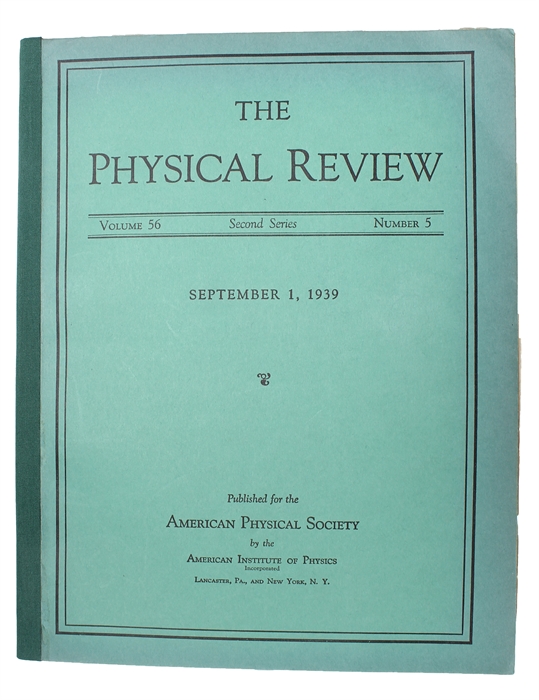THE FIRST THEORETICAL DESCRIPTION OF A SINGULARITY
BOHR, N. (+) J. A. WHEELER (+) J. R. OPPENHEIMER (+) H. SNYDER.
The mechanism of nuclear fission [N. Bohr. & J. A. Wheeler] "On continued gravitational contraction" [J. R. Oppenheimer & H. Snyder].
Lancaster, American Institute of Physics, 1939.
Royal8vo. In the original green printed wrappers. In "The Physical Review", Volume 56, Second Series, Number 5, September 1. With cloth back-strip. A quire, affecting both papers, detached but without any loss of paper. A few minor tear throughout, far from affecting text. [Bohr & Wheeler:] Pp. 426-50. [Oppenheimer & Snyder:] Pp. 455-59. [Entire volume: Pp. 387-486].
First printing of two landmark papers, all of seminal importance in history of physics: The intricacies of the fission process, the groundwork for atomic and hydrogen bombs and the forgotten birth of black holes: The first theoretical description of a black hole, the production of a singularity when a sufficiently large neutron star collapses.
Oppenheimer and Snyder's "ON CONTINUED GRAVITATIONAL CONTRACTION" constitute the very first theoretical prediction of a singularity when a sufficiently large neutron star collapses. This phenomenon was later to be coined as a black hole. "Had J. Robert Oppenheimer not led the US effort to build the atomic bomb, he might still have been remembered for figuring out how a black hole could form." (American Physical Society). The paper has by several physics historians been described as the forgotten birth of black holes.
"Oppenheimer and his graduate student George Volkoff presented the first analysis of the formation of a neutron star in a 1939 Physical Review paper titled, "On Massive Neutron Stars". Oppenheimer wondered what would happen to a very massive neutron star. The Schwartzschild analysis of General Relativity has a theoretical limit, called the "Schwartzschild limit", when the ratio of mass-to-radius of a star is 236,000 times greater than the ratio for our sun. When this limit is exceeded, the Schwartzschild analysis does not yield a solution. Oppenheimer believed that a neutron star could have sufficient mass to exceed this limit. What would happen to it?
Oppenheimer and his graduate student Hartland Snyder applied General Relativity theory to a star with sufficient mass and density to exceed the Schwartzschild limit. The Schwartzschild analysis assumed that the size of the star stays constant with time. Oppenheimer and Snyder found that they could achieve a real solution from General Relativity when the Schwartzschild limit is exceeded by assuming that the diameter of the star decreases with time. They presented their analysis in a 1939 Physical Review paper, titled, "On Continual Gravitational Contraction," which concluded with:
"When all thermonuclear sources of energy are exhausted, a sufficiently heavy star will collapse. Unless fission due to rotation, the radiation of mass, or the blowing off of mass by radiation, reduce the star's mass to the order of that of the sun, this contraction will continue indefinitely."
This analysis concluded that when the Schwartzschild limit is exceeded, the star must collapse indefinitely until it reaches a singularity having an infinite density of matter" (Bjornson, Singularity Predictions of General Relativity, P. 4).
The Chandrasekhar / Eddington controvery in the mid 30ies did discuss the fate of neutron stars but the first thoroughly theoretical desciption was first published here.
"THE MECHANISM OF NUCLEAR FISSION" is the first fully worked out theory of nuclear fission, which laid the groundwork for atomic and hydrogen bombs.
"Wheeler's technical mastery of physics is best seen in the classic paper of Bohr and Wheeler. Bohr and Wheeler wrote the paper in Princeton, where Bohr was visiting in the spring of 1939, a few months after the discovery of fission. The paper is a masterpiece of clear thinking and lucid writing. It reveals, at the center of the mystery of fission, a tiny world where everything can be calculated and everything understood. The tiny world is a nucleus of uranium 236, formed when a neutron is freshly captured by a nucleus of uranium 235. The uranium 236 nucleus sits precisely on the border between classical and quantum physics. Seen from the classical point of view, it is a liquid drop composed of a positively charged fluid. The electrostatic force that is trying to split it apart is balanced by the nuclear surface tension that is holding it together. The energy supplied by the captured neutron causes the drop to oscillate in various normal modes that can be calculated classically. Seen from the quantum point of view, the nucleus is a superposition of a variety of quantum states leading to different final outcomes. The final outcome may be a uranium 235 nucleus with a re-emitted neutron, or a uranium 236 nucleus with an emitted gamma-ray, or a pair of fission-fragment nuclei with one or more free neutrons. Bohr and Wheeler calculate the cross-section for fission of uranium 235 by a slow neutron and get the right answer within a factor of two. Their calculation is a marvelous demonstration of the power of classical mechanics and quantum mechanics working together. By studying this process in detail, they show how the complementary views provided by classical and quantum pictures are both essential to the understanding of nature. Without the combined power of classical and quantum concepts, the intricacies of the fission process could never have been understood. Bohr's notion of complementarity is triumphantly vindicated" (John Archibald Wheeler, Proceedings of the American Philosophical Society 154 (2010)).
Order-nr.: 54015


![The mechanism of nuclear fission [N. Bohr. & J. A. Wheeler] "On continued gravitational contraction" [J. R. Oppenheimer & H. Snyder].](/images/product/54015b.jpg)
![The mechanism of nuclear fission [N. Bohr. & J. A. Wheeler] "On continued gravitational contraction" [J. R. Oppenheimer & H. Snyder].](/images/product/54015c.jpg)